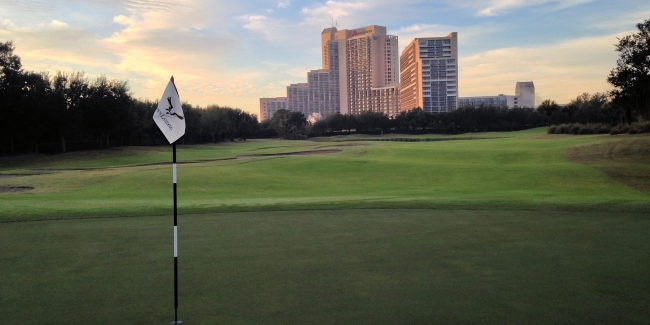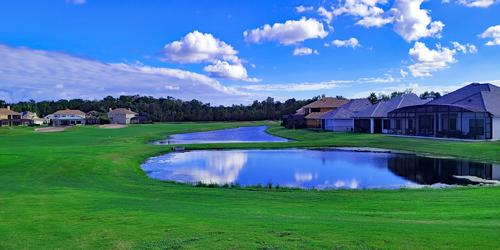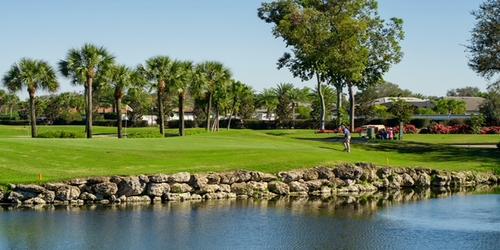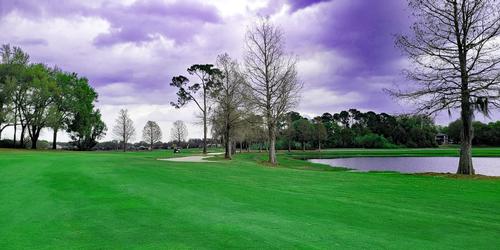
Hawk's Landing Golf Club
Florida Golf Course Review
By David Theoret
As part of the world's largest Marriott, Hawk's Landing Golf Club sees its fair share of play. The course was designed by renowned golf architect Joe Lee and opened in 1986. In 1998 the course underwent an extensive redesign at the hands of Robert Cupp Jr. From the back tees, this par 71 championship course plays 6602 yards with a course rating of 72.6 and a slope of 131. The green tees, at 6,165 yards, will give most golfers all they can handle.
Hawk's Landing Golf Club sits on more than 220 acres of prime real estate at Orlando's premier resort destination: the Orlando World Center Marriott Resort. It's also the home of the world-class Bill Madonna Golf Academy. And, in case you are old school, walking is allowed. Two large practice putting greens, a full length grass range and short game area make up the practice facilities at Hawk's Landing.
The golf course itself is a landscaping masterpiece; a special blend of native Florida wildlife and tropical vegetation. During the spring and summer months, brightly colored azaleas, fragrant jasmine, southern magnolias, and soaring queen palms make Hawk's Landing a nature lover's paradise with the wide variety of birds and wildlife they attract. All of this is enhanced by the bright Florida sunshine.
If the wet stuff makes you queasy, better get a box of Dramamine; water comes into play on 16 holes and sometimes twice on the same hole. As with most Florida courses water is the biggest hazard to overcome because the terrain is pretty flat, although some undulation has been created in some of the fairways.
Memorable Holes
( all yardage is from the Green tees; 6,165 yards, par 71, course rating - 70.3, slope - 129)
Number 1: Par 4, 395 yards. Depending on your tee selection, the bunker complex on the right can be carried. Just don't go too far right as a number of small pines can come into play and obscure your view. Get to the dogleg from any set of tees and you're looking at a mid-iron to wedge into a fairly flat green protected left and rear by deep bunkers. This hole can easily be the start to a memorable (and low scoring) round.
Number 4: Par 5, 507 yards. This is one of those holes where the same water comes into play more than once. From the tee box, the water is all down the right side and comes into play a lot more as you get nearer the hole. From our tees, there was enough room for me to hit driver. Depending upon how well you hit your tee shot, your next one is all risk/reward. Long ball hitters can have a go, just be wary of the water next to the green. For the rest of us, the water will now be on the left of your layup with a fairway bunker looming on the right side about 80 yards short of the green. Club selection is critical on approach if you want to get it close to the pin on this multi-tiered green. Par is good here.
Number 7: Par 3, 213 yards. My playing partner, being in his 70's, joked about laying up on this hole. It's a fairly straightforward par 3 with a cluster of bunkers half way up the fairway that shouldn't come into play and a lone deep bunker on the left, which would definitely influence shot selection on a left side pin placement. Hit it short and the bump and run shot - a favorite of seniors in Florida - is definitely a possibility.
Number 11: Par 4, 364 yards. Although handicapped as the course's 15th hardest hole, this one gave my group fits, mainly because none of us had played the course before. Tee shots need to be kept left, away from the tree line or risk having to face a miraculous approach shot. A good tee shot that finds the fairway will leave an approach shot over water to a green protected by water in the front and right. Anything long has a good chance of finding the water as well. A fun hole that I would definitely play differently next time.
Number 12: Par 4, 378 yards. More water to navigate here as well as a long waste bunker that abuts the water the entire length of the landing area on the left. Just like the first hole, a good tee shot will leave a mid-iron to wedge into a small green which sits well below the fairway. Anything left of the green or short is wet.
Number 18: Par 5, 550 yards. The course's #1 handicap with - you guessed it - more water. Off the tee you will need to navigate a cluster of fairway bunkers on the left and one on the right of the fairway. Anything right of the bunkers left and you will have to deal with the tree line which I learned on a previous hole is not a lot of fun. The landing area for your layup shot is a narrow strip of fairway leading to an approach shot over more water. Anything long is likely to find H2O as well. Par is a great way to end your round at Hawk's Landing.
Last Word:
The course conditioning at Hawk's Landing is reminiscent of that of a country club, meticulously maintained with large TifDwarf Bermuda greens that roll true. They were on the slower side the day I played but I was told they usually play faster.
The first time around the course is an adventure, especially if no one in the group knows the course. Knowing where to hit tee shots is critical here as there is a lot of water. It may be a good idea to pack an extra sleeve or two of balls and leave the good ones in your bag.
Number 18 is a hole I will remember for a long time, especially the layup shot. Two good shots here will still leave most golfers with an above average length approach shot to a very shallow green.
For a course that plays only 6,600 yards from the back tees, Hawk's Landing is quite a challenge. For more information or to book a tee time, call the pro shop at (407) 238-8660 or visit their website: www.golfhawkslanding.com.
Revised: 12/23/2014 - Article Viewed 29,742 Times
- View Course Profile
About: David Theoret
![]() David Theoret has been in the golf and golf travel industry for over 10 years, primarily selling online advertising. For the past seven years, he has also been a golf writer, reviewing golf courses, resorts, destinations, equipment, golf apparel, and training aids - the latter of which never seems to help. David's articles and reviews have been posted on many golf travel and equipment websites.
David Theoret has been in the golf and golf travel industry for over 10 years, primarily selling online advertising. For the past seven years, he has also been a golf writer, reviewing golf courses, resorts, destinations, equipment, golf apparel, and training aids - the latter of which never seems to help. David's articles and reviews have been posted on many golf travel and equipment websites.
Growing up in Southwestern Ontario, Canada, it was naturally assumed he would play hockey. Beginning at the age of 3 and continuing into his late 30's, he did just that. However, after one too many pucks to the head, he realized that golf was a lot easier on the body (whoever said hockey players were slow) and took the game up.
After moving to Florida and accepting a position with TravelGolf Media (now part of GolfNow) his love for the game grew exponentially. Most Saturdays you will find him on a course somewhere in Florida or on the practice range reinforcing his bad habits. David plays to a 10 handicap - unless there is money involved in which case it goes considerably higher. He currently resides in Lakeland, FL with his wife Belinda and their two "kids", Madyson and Molly.
Contact David Theoret:
GolfTrips.com - Contributor











